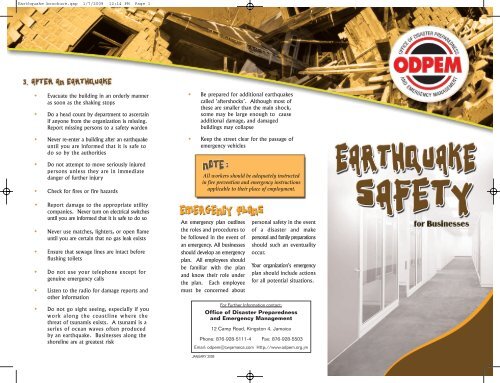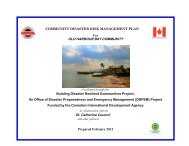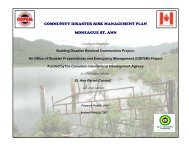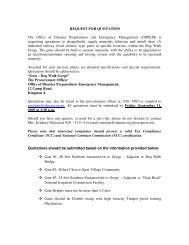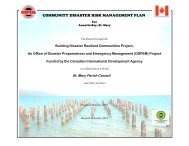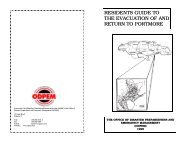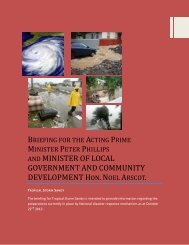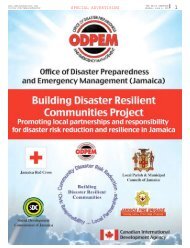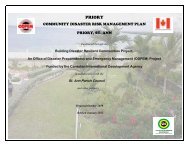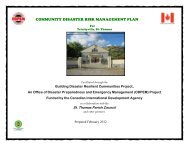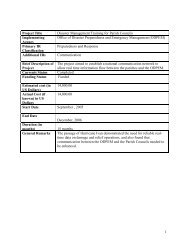Earthquake brochure - ODPEM
Earthquake brochure - ODPEM
Earthquake brochure - ODPEM
You also want an ePaper? Increase the reach of your titles
YUMPU automatically turns print PDFs into web optimized ePapers that Google loves.
<strong>Earthquake</strong> <strong>brochure</strong>.qxp 1/7/2009 12:14 PM Page 1• Evacuate the building in an orderly manneras soon as the shaking stops• Do a head count by department to ascertainif anyone from the organization is missing.Report missing persons to a safety warden• Never re-enter a building after an earthquakeuntil you are informed that it is safe todo so by the authorities• Do not attempt to move seriously injuredpersons unless they are in immediatedanger of further injury• Check for fires or fire hazards• Report damage to the appropriate utilitycompanies. Never turn on electrical switchesuntil you are informed that it is safe to do so• Never use matches, lighters, or open flameuntil you are certain that no gas leak exists• Ensure that sewage lines are intact beforeflushing toilets• Do not use your telephone except forgenuine emergency calls• Listen to the radio for damage reports andother information• Do not go sight seeing, especially if youwork along the coastline where thethreat of tsunamis exists. A tsunami is aseries of ocean waves often producedby an earthquake. Businesses along theshoreline are at greatest risk• Be prepared for additional earthquakescalled ‘aftershocks’. Although most ofthese are smaller than the main shock,some may be large enough to causeadditional damage, and damagedbuildings may collapse• Keep the street clear for the passage ofemergency vehiclesAll workers should be adequately instructedin fire prevention and emergency instructionsapplicable to their place of employment.An emergency plan outlinesthe roles and procedures tobe followed in the event ofan emergency. All businessesshould develop an emergencyplan. All employees shouldbe familiar with the planand know their role underthe plan. Each employeemust be concerned aboutpersonal safety in the eventof a disaster and makepersonal and family preparationsshould such an eventualityoccur.Your organization’s emergencyplan should include actionsfor all potential situations.For Further Information contact:Office of Disaster Preparednessand Emergency Management12 Camp Road, Kingston 4, JamaicaPhone: 876-928-5111-4 Fax: 876-928-5503Email: odpem@cwjamaica.com Http://www.odpem.org.jmJANUARY 2009
<strong>Earthquake</strong> <strong>brochure</strong>.qxp 1/7/2009 12:14 PM Page 2Jamaica’s location along the northern margin of the CaribbeanPlate and the presence of very active faults on the island, makesit vulnerable to earthquakes. An earthquake is a sudden shakingor trembling of the earth caused by the shifting of the rocksbeneath the earth’s surface.It is important for Jamaicans to understand that earthquakes canoccur anywhere on the island. Building codes that requireearthquake-resistant construction should be followed, as well asmitigation measures which can reduce injury and damage.During an earthquake, the earth moves like the deck of aship. The actual movement of the ground, however isseldom the cause of injury or death. Most deaths are causedby the collapse of structures. Injuries are commonlycaused by:• Building collapse or damage, falling blocks, roofs,ceiling plaster, light fixtures and pictures• Flying glass from broken windows. Thisdanger may be even greater for thosebusinesses located in high rise structures• Overturned bookcases, wall units, filingcabinets, and other office furniture• Fires from ruptured gas and electrical lines.This danger may also be aggravated by a lackof water due to broken water mains• Fallen power lines• Train and vehicular accidentsAlthough earthquakes strike without warning, there aremany actions that can be taken to reduce their impact. Itis important that precautions be taken before anearthquake occurs.Buildings should be inspected for:1. cracks and weaknesses2. defective electrical wiring3. inflexible gas connections and leaking gas4. objects that could topple, causing injury• Bolt down water heaters and gas appliances• Know where and how to shut off electricity,gas and water at main switches and valves• Place large or heavy objects on lower shelves• Securely fasten shelves and filing cabinets towalls. Computers should be attached to desks• Strap down high or top heavy objects• Bottles, glass, china, and other breakablesshould be stored in low cabinets. All cabinetsshould be kept locked• Overhead lighting fixtures, such as chandeliers,and fluorescent bulbs should be securelyanchored and covered• Practise earthquake drills regularly so employeesknow what to do in an earthquake. This wouldinclude:qqqqthe evacuation of the buildingthe identification of an open space asan assembly point after the earthquakethe formation and training of a safetycommitteedeveloping a disaster plan• Flashlights andbattery operatedradios in casepower is cut off• Fire extinguishers• First Aid kits• Stay calm—think through the consequencesof any action you take• If you are inside, stay inside. Take cover undera heavy desk, table, bench, in a supporteddoorway or a corner• If you are in a high rise building, get undera desk or similar heavy furniture. Whenthe shaking stops, evacuate by stairway.Never use elevators during an earthquake• If you are outdoors, stay outdoors.During earthquakes, most injuries occur aspeople are entering or leaving buildings.Move away from buildings and utility wires.Do not run through streets. If you are in anopen space, stay there until the shaking stops


